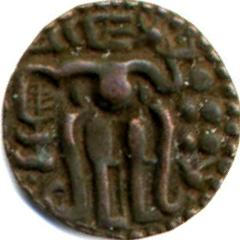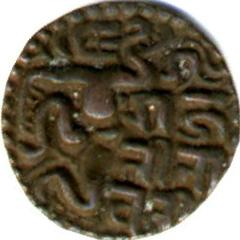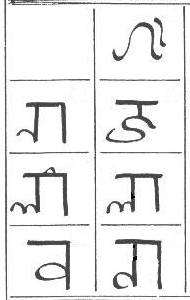| SPECIFICATIONS | |
| Denomination | massa |
| Alloy | Copper |
| Type | Struck |
| Diameter | 20.47 mm |
| Thickness | mm |
| Weight | 4.26 gms |
| Shape | Round |
| Edge | Plain |
| DieAxis | O° |


|

| 
| ||||||||||||||||||||
| Codrington #80 | Mitchiner #837-839 | |||||||||||||||||||||
|
Obverse : Traditional Lankan massa design of standing king. The head consists of an irregular oblong, the right side being a vertical line, from which projects three horizontal stokes representing the nose, mouth and chin. The crown bulging outwards at the back. The two curved lines on either side of the legs slightly turned upwards at the end indicate a person wearing a 'dhoti', and standing on a lotus stalk with flower to the right. The forearm is bent sharply down; the hand grasps the hanging lamp. The right side elbow is curved down with the arm turned upwards holds a flower presumed to be a jasmine blossom. To the right are five dots or spheres. A rim of 40 to 43 beads. Reverse : Traditional Lankan massa design of seated king. Head and crown as on obverse. Arm is raised upwards and the hand holds a conch shell. On right Nagari legend Sri Ra ja Li la va ti | 
|
This is one of six fairly common copper massa coins from the late Polonnaruwa and Dambadeniya era. The base silver type is also known.
To quote history from the direct translation of the ancient chronicle
Culavamsa
... In 1197
the powerful general Kitti had the eyes of this king Codaganga put out, deposed him
and had the government carried on for three years without mishap by
the first mahesi of Parakramabahu
Queen Lilavati.
... In 1209
the general, Vikkantacamunakka, the villain, slew the Monarch
Anikanga and had the government carried on for a year by the first
Mahesi of King Parakramahihu, Lilavati by name, who had already
reigned before.
Now came King Lokissara by name, who had been wounded in the shoulder
by a spear, with a great Damila army from the opposite shore, brought
the whole of Lanka under his sway and reigned, dwelling in
Pulatthinagara (Polonnaruva), nine months.
Hereupon In 1211
the general Parakrama, the best among men of decision, endowed with
great power and courage, belonging to the family of the Kalanagaras,
consecrated the Mahesi Lilavati who came of the dynasty of the Sun and
Moon, in the royal dignity, she who afterward shone in royal
splendor. When then a space of about seven months had passed for the
Mahesi, there landed with a great Pandu army from the Pandu kingdom
the glorious Pandu King Parakrama, deposed the Queen and her general
Parakkama and after he had cleared Lanka from the briers (of revolt),
he ruled the realm in superb Pulatthinagara for three years.
Text edited from
* Ceylon Coins and Currency: H. W. Codrington, Colombo, 1924.
Chapter VI Mediaeval Lanka - Sinhala of 12th & 13th Century - Series I, Page 69
* Culavamsa II Chapter LXXX: Translation by Wilhelm Geiger. Pali Text Society 1930
The coin was scanned at 300dpi and displayed at 300dpi is from my original collection from Lanka.